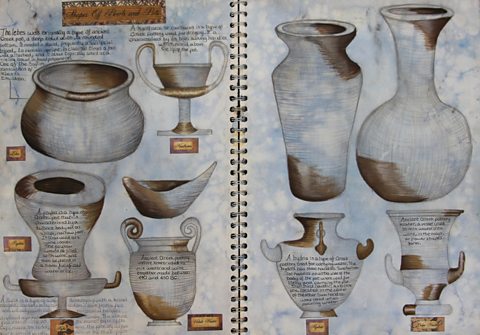Recording observations


It is important to observe your sources and stimuli closely. Make a mental note of general proportionHow the sizes of different parts of something relate to each other., overall shape, size, fall of light, colour and shadows, or other visual characteristics such as surface texture, before starting a study.
When studying the work of other artists, designers and craftspeople really examine their use of media and materials, techniques, visual elements and design principles.
Observations can be recorded using images, models and words. Examples of observations are:
- detailed analytical studies
- photographs, quick sketches, small 3D models or maquettes based on primary or secondary sources
- mixed media studies recording textures, colour, design or patterns from what you are observing
To convey your ideas, observations and intentions successfully, you need to refine your practical skills with your chosen media and materials.
Drawing to record observations
Drawings could be quick sketches, or a more sustained approach to show you are refining your ideas and skills. You should select a medium or process based on the subject matterThe topic or objects chosen for representation in an expressive artwork. In portraiture, the person represented is referred to as the āsubjectā or āsitterā., and work from a range of stimulus material.
Using photography to record observations
It's easy to take a digital photograph of something and print the picture, but you must show that you have developed your skills of selection and control.
You should consider the subject matter and compositionArrangement of different elements within an artwork or design. of your image, and the effects of different lighting and exposureThe amount of light that enters a camera to produce an image.. You should think about how you will print and present your photographs.
Experiment with viewpointThe place or position from which the artwork was created. Examples include eye level, from an elevated position and bird's eye view., framing, and focus in order to create a more atmospheric, expressive or stylised image.
Checklist
When recording observations have you:
- recorded objects, artefacts, people and places?
- used the work of artists, designers and craftspeople?
- selected and experimented with different media?
- made detailed analytical studies?
- made quick sketches, taken photographs or produced models or samples?
When drawing to record observations have you:
- selected appropriate media and techniques?
- looked carefully at your subject?
- recorded formal or visual qualities such as line, tone or texture?
- developed and refined your skills?
- worked from a range of sources and stimulus material?
When using photography to record observations have you:
- selected and framed your subject carefully?
- chosen interesting viewpoints?
- explored elements of visual language such as colour, tone and form?
- controlled composition?
- controlled focus, depth of fieldThe distance between the nearest and furthest parts of a photograph that are in clear focus., lighting and exposure?
More guides on this topic
- Finding inspiration - Edexcel
- Responding to stimuli - Edexcel
- Analytical drawing - Edexcel
- Developing ideas - Edexcel
- Creating a design brief - Edexcel
- Experimenting with materials and techniques - Edexcel
- Annotating your work - Edexcel
- Analysing and evaluating - Edexcel
- Assessment objectives and presenting your work - Edexcel
- Externally set assessment - Edexcel